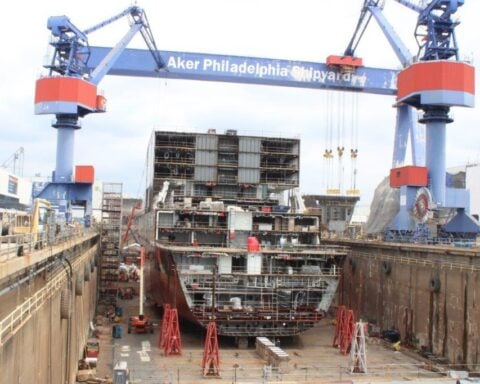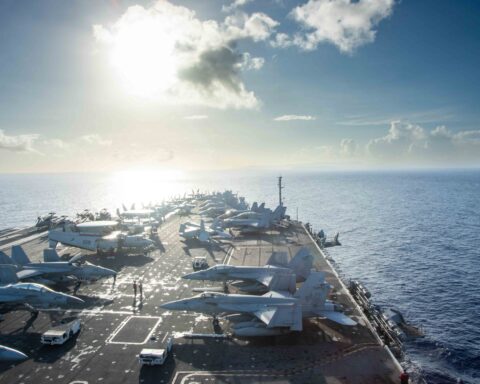
A Russian intelligence ship transited through a Japanese Strait on Friday according to a Joint Staff Office release. Meanwhile, Japan plans to begin in July a deep-sea search for the wreckage of two Japan Maritime Self-Defense Force SH-60K helicopters that collided with each other in April during a training exercise.
In other developments, the U.S. military has conducted a number of engagements with big deck ships of partner nations.
In a Friday release, the JSO reported that at 7 p.m. Thursday, Russian intelligence ship Pribaltica (80) was sighted sailing northeast in an area 31 miles west of Rebun Island, which lies 31 miles off the northwest tip of the main island of Hokkaido. The JSO stated that from Thursday to Friday, Pribaltica sailed east through La Perouse Strait. JMSDF fast attack craft JS Wakataka (PG-825) and a JMSDF P-3C Orion Maritime Patrol Aircraft (MPA) of Fleet Air Wing 2 based at JMSDF Hachinohe Air Base on the main island of Honshu shadowed the Russian ship.
La Perouse Strait divides the Russian island of Sakhalin from Hokkaido, and connects the Sea of Japan on the west with the Sea of Okhotsk on the east and is also largely an international waterway given its 16 mile width and the fact that Japanese territorial waters there only extends to 2 nautical miles instead of the normal 12 nautical miles. Russian Navy ships routinely transit the strait for their operations though the JMSDF routinely monitors such transits and has its ships and aircraft shadowing the Russian ships along with also People’s Liberation Army Navy ships operating near Japan with the JSO issuing regular reports on the movements of such ships around Japan.
On Friday during his regularly scheduled press conference, Japan Defense Minister Minoru Kihara announced that a deep sea search for the wreckage of the two JMSDF SH-60K helicopters which collided in April would begin in July using the towed Deep Tow deep sea surveying system owned by the Japan Agency for Marine-Earth Science and Technology (JAMSTEC). Kihara stated that since April 27, JMSDF oceanographic survey ship JS Shonan (AGS-5106) had been conducting a search for the helicopters but has been unable to find the helicopters which lie at a depth of 18,045 feet below sea level.
Flight recorders and parts of the helicopters had been recovered after the incident but not the main bodies of both helicopters. Eight JMSDF personnel were killed in the incident but only one crewman was recovered, the JMSDF on Tuesday formally declared the seven missing personnel as deceased.
In other developments, the U.S. military has conducted a number of engagements with big deck ships of partner nations, off the East Coast, the Navy and Marine Corps are carrying out Exercise Chesapeake 2024 with the French Navy Jeanne d’Arc amphibious task group comprising of amphibious assault ship FS Tonnerre (L9014) and frigate FS Guepratte (F714) with embarked French naval academy cadets and a French Army battlegroup. Taking place from Thursday to Sunday, Exercise Chesapeake aims to enhance interoperability, strengthen the bilateral defense partnership, and increase understanding of allied capabilities according to a navy release. “This exercise is a testament to the strength of our bilateral defense relationship with France, our oldest friend and ally, and our shared commitment to global security,” said Vice Adm. Doug Perry, commander, U.S. 2nd Fleet in the release.
 Throughout Exercise Chesapeake, U.S. and French naval forces will conduct cross-deck flight and well deck operations to demonstrate and enhance interoperability and increase their ability to operate together effectively, according to the release. “A week after the D-Day commemorations in France, this exercise illustrates the dynamism of the historic friendship that links our two nations in this symbolic place, the Chesapeake Bay,” said Capt. Adrien Schaar, commander of the Jeanne d’Arc amphibious task group and commanding officer of Tonnerre in the release. “It is also the demonstration of our ability to plan and conduct high-intensity operations together not only throughout our interoperability, but also through our ability to integrate each other’s assets on our platforms.”
Throughout Exercise Chesapeake, U.S. and French naval forces will conduct cross-deck flight and well deck operations to demonstrate and enhance interoperability and increase their ability to operate together effectively, according to the release. “A week after the D-Day commemorations in France, this exercise illustrates the dynamism of the historic friendship that links our two nations in this symbolic place, the Chesapeake Bay,” said Capt. Adrien Schaar, commander of the Jeanne d’Arc amphibious task group and commanding officer of Tonnerre in the release. “It is also the demonstration of our ability to plan and conduct high-intensity operations together not only throughout our interoperability, but also through our ability to integrate each other’s assets on our platforms.”
The release stated that U.S. Navy participating units include Commander, U.S. 2nd Fleet, Amphibious Squadron 8, amphibious dock landing ship USS Carter Hall (LSD-50), Naval Beach Group Detachment 2 and a detachment from Helicopter Sea Combat Squadron (HSC) 28. U.S. Marine Corps units include Marine Forces Command, II Marine Expeditionary Force (MEF), 22nd Marine Expeditionary Unit (MEU) 2nd Marine Aircraft Wing (MAW), 2nd Marine Logistics Group (MLG) and subordinate commands.
On June 7 in the Red Sea, the Dwight D. Eisenhower Carrier Strike Group (CSG) consisting of carrier USS Dwight D. Eisenhower (CVN-69) and destroyers USS Laboon (DDG-58) and USS Gravely (DDG-107) conducted a formation sail with Italian Navy aircraft carrier ITS Cavour (CVH-550) and frigate ITS Alpino (F-594), and French frigate FS Forbin (D-620). Forbin operated together with Cavour and Alpino from June 7-9 in the Red Sea with the French frigate deployed in the area under Operation Aspides, the European Union mission to protect commercial shipping in the Red Sea. Cavour and Alpino are now making their way to the Indo-Pacific for a deployment which includes having the Cavour’s embarked air wing of F-35Bs Lighting II fighters and AV-8 Harrier II fighters taking part in the Royal Australian Air Force’s Pitch Black multinational exercise taking place from July 12 to August 2 in Australia.
Also on June 7 in the Philippine Sea, carrier USS Ronald Reagan (CVN-76), together with U.S. 7th Fleet flagship USS Blue Ridge (LCC-19), cruiser USS Robert Smalls (CG-62), destroyers USS Higgins (DDG-76) and USS Rafael Peralta (DDG-115) joined Japan Maritime Self-Defense Force (JMSDF) destroyer helicopter carrier JS Izumo (DDH-183), destroyer JS Haguro (DDG-180) and submarine JS Jingei (SS-515) to carry out a formation sailing event as part of the Valiant Shield 2024 exercise. Izumo, Haguro and destroyer JS Ariake (DD-109) form the 2nd surface unit of the JMSDF’s Indo-Pacific Deployment 2024 mission, the JMSDF’s annual regional presence and engagement deployment.





